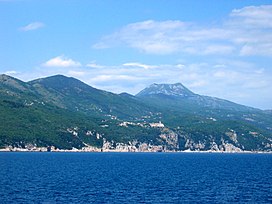geo.wikisort.org - Mountains
The Učka ([ˈut͡ʃka], Italian: Monte Maggiore) is a mountain range in western Croatia. It rises behind the Opatija riviera, on the eastern side of the Istrian peninsula.
| Učka | |
|---|---|
 View from Kvarner Gulf | |
| Highest point | |
| Peak | Vojak |
| Elevation | 1,396 m (4,580 ft) |
| Coordinates | 45°17′6″N 14°12′7″E |
| Geography | |
 Učka Location in Croatia | |
| Country | Croatia |
| Parent range | Dinaric Alps |
It forms a single morphological unit together with the Ćićarija range which stretches from the Bay of Trieste to Rijeka. Učka is a limestone massif with numerous areas of karst, stretching for 20 km from the Poklon Pass (920 m) to Plomin Bay, and is between 4 and 9 km wide.[1]
It differs from all the other coastal mountains in Croatia because of its abundant vegetation on the seaward side. Best known are the forests of sweet chestnuts in the area around Lovran.
Učka's highest peaks are considered nature reserves and memorial areas. The highest peak, Vojak, is located at 1396 meters above sea level.[2] From it there are views over Istria, the Bay of Trieste, the Julian Alps and the Adriatic islands, right down to Dugi Otok.[1]
The subject of a degree of local folklore, Učka is visible from much of the peninsula and is snow-capped some months of the year. The town of Opatija (Italian: Abbazia) is said to have derived its popularity as a resort in Imperial Austria because it is located "in the shade" of Mt. Učka, which by legend shields it from the fierce Mediterranean heat in summertime.
The area of Učka is designated a nature park (park prirode), a kind of protected area in Croatia.
Historically, the Istro-Romanians, a Romance ethnic group of Istria, have been separated by the mountain range, forming two areas of concentration: one in the village of Žejane and one in the village of Šušnjevica and the surrounding settlements. Although these areas are 50 kilometers away from each other, there is a road around the Učka that connects them.[3]
See also
- Učka Tunnel
References
- Naklada Naprijed, The Croatian Adriatic Tourist Guide, pg. 89, Zagreb (1999), ISBN 953-178-097-8
- Ostroški, Ljiljana, ed. (December 2015). Statistički ljetopis Republike Hrvatske 2015 [Statistical Yearbook of the Republic of Croatia 2015] (PDF). Statistical Yearbook of the Republic of Croatia (in Croatian and English). Vol. 47. Zagreb: Croatian Bureau of Statistics. p. 48. ISSN 1333-3305. Retrieved 27 December 2015.
- Vrzić, Zvjezdana; Singler, John Victor (2016). Ferreira, Vera; Bouda, Peter (eds.). "Identity and language shift among Vlashki/Zheyanski speakers in Croatia" (PDF). Language Documentation & Conservation Special Publication. 9: 51–68.
External links
На других языках
[de] Učka
Die Učka ([.mw-parser-output .IPA a{text-decoration:none}ˈut͡ʃka], ital. Monte Maggiore) ist ein Gebirge in Kroatien. Es ist das größte Gebirgsmassiv an der östlichen Seite der Halbinsel Istrien. Sie befindet sich nahe der Stadt Rijeka und oberhalb der Rivijera von Opatija.- [en] Učka
[fr] Učka
L'Učka (en italien : Monte Maggiore) est un massif montagneux du nord-ouest de la Croatie appartenant aux Alpes dinariques. Son point culminant, le mont Vojak (1 401 mètres[1]), est la plus haute montagne de la péninsule d'Istrie[2].[ru] Учка
У́чка (хорв. Učka; итал. Monte Maggiore) — горный массив на северо-западе Хорватии, на полуострове Истрия. Наибольшая высота — 1401 м (гора Вояк, по другим данным — 1394 м), другие выделяющиеся вершины — Сухи Врх (1332 м), Перун (881 м), Бргуд (907 м), Кременяк (827 м), Сисол (835 м) и др.[1] Название «Учка» происходит от хорв. Vučka, означающего «Волчья гора»[1].Другой контент может иметь иную лицензию. Перед использованием материалов сайта WikiSort.org внимательно изучите правила лицензирования конкретных элементов наполнения сайта.
WikiSort.org - проект по пересортировке и дополнению контента Википедии